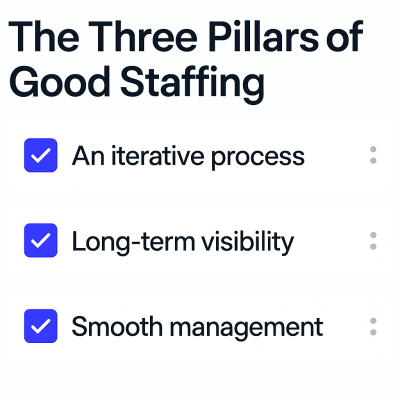In an agency, everything hinges on a delicate equation: delivering quality results, on time, with effective project management and a productive team capable of overcoming challenges.
But all too often, staffing is a source of constant tension. Resources mobilized on several missions, schedules adjusted in a hurry and conflicts detected too late. You spend more time putting out fires than calmly managing your business, with a workload that becomes overwhelming and objectives that are difficult to achieve.
This reactive management style slows down performance and exhausts your teams. However, there is another approach: integrate staffing and project management right from the quotation phase to anticipate needs, avoid conflicts and adjust resources flexibly.
How can you transform your staffing management to improve agility and profitability? What are the concrete levers to activate for smoother, more efficient planning? Here’s how.
Project management: the current challenge for agencies
The bottom line: run-of-river staffing doesn’t work
If you still manage your projects with a reactive approach, you’ve probably already faced these situations:
- You discover too late that an employee has already been assigned to another job.
- You’re forced to turn your schedules upside down in a hurry to distribute the workload.
- You lack visibility over your resources, which complicates project management and the achievement of objectives.
Fragmented project management leads to a loss of agility, longer deadlines and lower profitability. The later adjustments are made, the more costly they are, both in terms of time and energy for your teams. A poorly distributed workload also undermines team productivity, making efforts to achieve objectives even more difficult.
Conversely, an early and fluid approach optimizes team allocation, distributes workloads more evenly, reduces conflicts and improves project profitability. Efficient resource and staffing management ensures that each employee is assigned to where he or she is most needed, thus maximizing overall efficiency.
Iterative and forward-looking staffing: the winning combination
The three pillars of good staffing

Efficient staffing should not be a daily struggle, but a fluid, natural process. Yet too many agencies continue to manage their resources on a day-to-day basis, without any real anticipation. workload.
The result? Overloaded teams on some projects, while others lack resources at critical moments, which hampers productivity and delays the achievement of objectives. Proactive, structured management is therefore crucial to avoid these imbalances.
The real challenge is to staff for the long term. By integrating staffing right from the quotation phase, and projecting resources over the entire duration of the project, you avoid permanent adjustments and gain in stability. This approach ensures that every team member know in advance what they’ll be working on, and managers can better distribute the workload without last-minute stress.
The three pillars of high-performance staffing are clear:
- An iterative process
Planning evolves naturally, according to project needs and team availability. - Long-term visibility
You can plan your resources well in advance, anticipating conflicts and avoiding periods of understaffing. - Smooth management
80% of the schedule is structured from the outset, reducing mental workload and unforeseen adjustments.
With proactive planning and intelligent resource allocation, you can avoid imbalances and decisions made in a hurry.
Concrete benefits for your agency
Integrating staffing and project management enables you to transform the way you manage your resources. In concrete terms, this means :
- Save time – By limiting last-minute emergencies, you have more time to take stock of ongoing projects and adjust your strategy.
- Fewer conflicts – Everything is set in stone from the outset, reducing the tensions associated with a lack of organization, and ensuring better coordination throughout the project.
- Better visibility – You know exactly what resources are available and when, which facilitates decision-making and enables you to mobilize an effective team at the right time.
- Data-driven management and KPI monitoring – When staffing and project management are well integrated, you can monitor the actual time spent on each project in real time, and compare it with the time initially planned. This analysis enables you to quickly identify discrepancies, adjust workloads and even make predictions: if a project regularly exceeds its time budget, you can detect it long before it becomes a problem.
- Controlled growth – You can take on more projects without the risk of overloading your staff, because you know exactly where you stand and can adjust your resources according to actual forecasts, for smoother, more controlled project management.
With this approach, every project is launched on a solid footing, with optimized resource management.
How to take action?
Structuring a clear workflow
- Each work slot is directly linked to a specific task.
- Employees know immediately what they need to do, depending on their availability.
- Project tracking is simplified, as each action is planned and attached to a resource.

Why do agencies fail?
Many agencies are struggling to adopt this approach for several reasons:
- Lack of suitable tools – Staffing management is often based on spreadsheets or solutions that are too rigid, preventing agile, centralized planning.
- A culture of reactivity – The habit of managing emergencies rather than anticipating them leads to constant overloading of teams, a poorly distributed workload and last-minute adjustments that damage profitability. It also leads to a less productive team, as resources are constantly readjusted rather than optimally utilized.
- Separate project management and staffing – When the two are separated, resources are allocated without taking strategic priorities into account, generating scheduling conflicts and a lack of flexibility.
- Poor integration of the customer into the process – All too often, customers are informed of schedules once they have been set, which limits their ability to anticipate and generates late requests that disrupt the agency’s organization. By integrating the customer from the outset – by sharing a vision of allocated resources and key milestones – the agency improves communication, reduces unforeseen events and gains in efficiency.
An agency that removes these obstacles and adopts a more transparent, collaborative model will have the means to improve its performance while securing its commitments.
The case of SMASH Group
To illustrate this approach, let’s take the example of SMASH Group, a French consulting firm founded in 2018. In just four years, they have gone from 0 to 55 employees, with annual growth of 50%, recruiting an average of 22 people a year. This rapid expansion has highlighted the need to optimize time management and centralize tools to maintain customer service quality.
The challenges faced by SMASH Group :
- Limited visibility
With rapid growth, it was becoming difficult to monitor team workloads in real time, which could lead to overloads and increased stress.
- Scattered tools
The use of Excel files for time tracking and administrative management lacked dynamism and didn’t provide an effective overview.
- Inadequate planning
The absence of a centralized system made planning and anticipating human resources needs complex.
Furious solutions:
- Real-time tracking
Thanks to Furious project management software, SMASH was able to precisely monitor the time spent on each project, anticipate recruitment requirements (skills needed) and plan tasks optimally. Says Jean-Baptiste Cousin, co-founder of SMASH: “We use Furious to monitor time very precisely, firstly to make sure we’re not overloading our teams and putting them under stress.”
- Centralized tools
By adopting the Furious project management tool, SMASH has replaced its Excel files with a single platform, offering a clear view of staffing, planning and time spent per customer in just two clicks.
- Improved planning
With an overview of schedules and automatic reminders for certain actions, task distribution and the anticipation of busy periods have been greatly improved.
The results have been significant: better visibility on projects, increased anticipation of staffing needs and reduced stress for teams. As Jean-Baptiste Cousin points out: “We’ve moved from the medieval to the digital era. With the arrival of Furious, we’ve moved into a much more dynamic era, with monitoring too, and of course data security.”

Why is Furious the ideal tool?
Furious has been designed for agencies looking for smoother, more efficient project management. Specifically, it enables you to :
- Planning right from the quotation phase – As soon as a project is approved, you know what resources will be mobilized and when.
- Detect conflicts well in advance – You can immediately identify potential overloads and resolve them before they become a problem.
- Save time with an ultra-intuitive interface – No complex settings, no cumbersome administration. Furious project management software automates what needs to be done.
- Benefit from 80% pre-built planning – All you have to do is adjust and refine, rather than starting from scratch with each project.
With Furious, you give your agency a real competitive edge: the ability to deliver your projects smoothly, with complete peace of mind.
Want to see the impact on your agency? Book your free demo today.